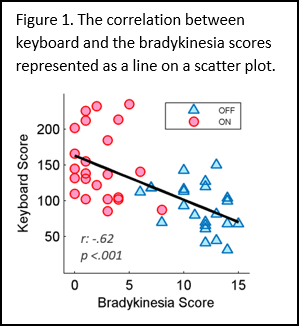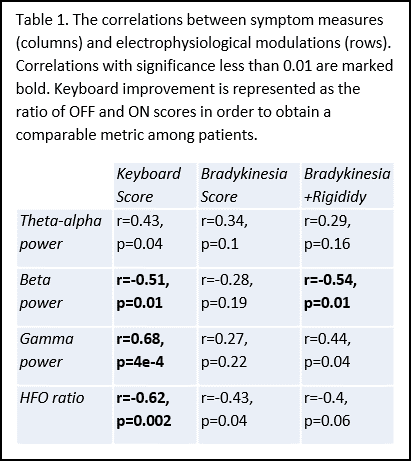Session Information
Date: Monday, October 8, 2018
Session Title: Parkinson's Disease: Pathophysiology
Session Time: 1:15pm-2:45pm
Location: Hall 3FG
Objective: Reliable and objective assessment of the symptoms of patients with Parkinson’s disease (PD) and the correlation of the measures with neural patterns is important for the development of a closed-loop therapy. To this end, we employed a computerized keyboard task (KB) alongside UPDRS, in order to quantify the bradykinesia (BK) severity and correlated both modalities with the modulations in the subbands of the local field potentials (LFPs).
Background: The UPDRS has been the standard clinical assessment tool for PD. Although its inter rater reliability was reported to be sufficient for cardinal symptoms of PD such as BK, its intra-rater reliability was shown to be low to moderate [1]. There have been attempts to measure the severity of the motor symptoms by using computer-assisted tasks, but they focus on correlating UPDRS with device measurements [2]. Here, we test these two modalities against the pharmacological modulations of LFP subbands.
Methods: The LFPs were recorded from the STN of nine patients with Parkinson’s disease (PD), using externalized DBS leads (#3389, Medtronic, MN) for three medication intake trials. The motor performance in the unmedicated (OFF) and medicated (ON) states were assessed separately for each trial by UPDRS items 22 (rigidity), 23-26 (BK) and a 30-second alternating KB task. The band powers of theta-alpha (4-12Hz), beta (13-30Hz), gamma (70-90Hz), and high frequency oscillations (HFOs, 200-400Hz) were computed using 10 minute data from both states. HFO change was represented as the ratio of 200-300Hz and 300-400Hz bands since they were mutually exclusive in each state. Due to the repeated samples, a mixed-model was used to find the correlations.
Results: Table1 summarizes the correlations between the improvement of symptoms and the changes in the LFP patterns. The improvement in KB always correlated better than BK for all electrophysiological markers. Also, keyboard score correlated better than the sum of BK and rigidity for all markers except beta band power. Additionally, the correlation between BK and KB was r: 0.65 (p<0.001, Figure1). [figure1][table1]
Conclusions: The moderate correlation between BK and KB shows that they do not completely agree. Although not comprehensive and conclusive, KB always explained the changes in the neural data better, compared to BK. This might be because the rater knew the patient’s state but was blinded to neural data. Due to the objective nature of KB task, the bias from the rater’s prior knowledge can be eliminated. Here, we used only the tap count for KB score. By more complex tasks, more information about the symptoms of PD can be captured [2]. In short, the superior correlations obtained from KB indicates that well-designed tasks can help determining the symptoms in a more reliable and standardized fashion.
References: [1] Camicioli, R. et al. (2001) ‘Discriminating mild Parkinsonism: methods for epidemiological research.’ Movement disorders : official journal of the Movement Disorder Society. United States, 16(1), pp. 33–40. [2] Taylor Tavares, A. L., Jefferis, G. S.X.E., Koop, M., Hill, B. C., Hastie, T., Heit, G. and Bronte-Stewart, H. M. (2005), Quantitative measurements of alternating finger tapping in Parkinson’s disease correlate with UPDRS motor disability and reveal the improvement in fine motor control from medication and deep brain stimulation. Mov. Disord., 20: 1286–1298. doi:10.1002/mds.20556.
To cite this abstract in AMA style:
M. Ozturk, A. Abosch, D. Francis, J. Wu, N. Ince. Quantitative Keyboard Tapping Measurement Correlates with Electrophysiological Changes in STN LFPs of PD Patients Treated with L-dopa Better Than UPDRS Subscores [abstract]. Mov Disord. 2018; 33 (suppl 2). https://www.mdsabstracts.org/abstract/quantitative-keyboard-tapping-measurement-correlates-with-electrophysiological-changes-in-stn-lfps-of-pd-patients-treated-with-l-dopa-better-than-updrs-subscores/. Accessed January 7, 2026.« Back to 2018 International Congress
MDS Abstracts - https://www.mdsabstracts.org/abstract/quantitative-keyboard-tapping-measurement-correlates-with-electrophysiological-changes-in-stn-lfps-of-pd-patients-treated-with-l-dopa-better-than-updrs-subscores/


